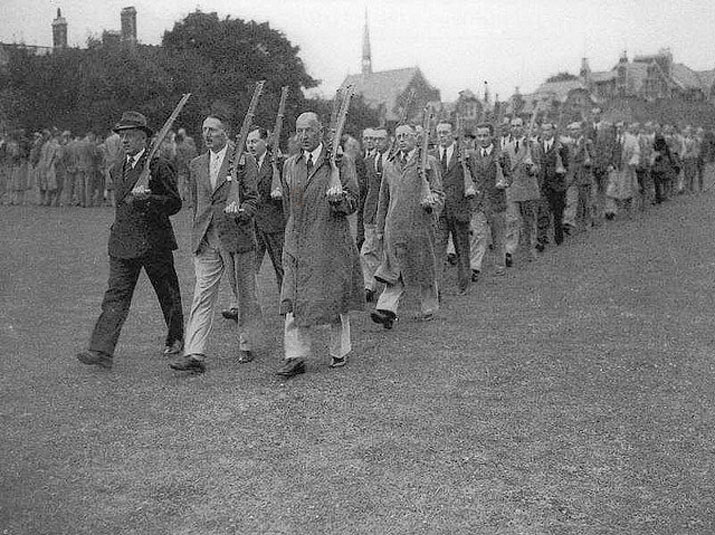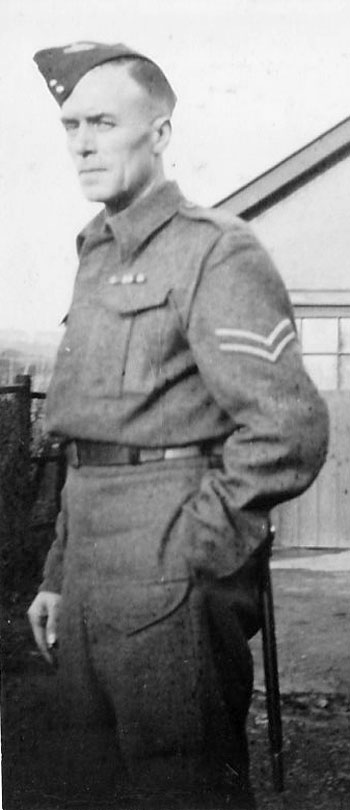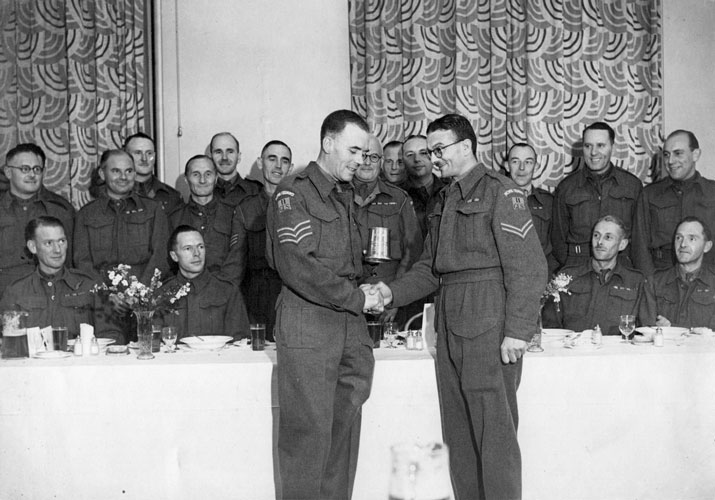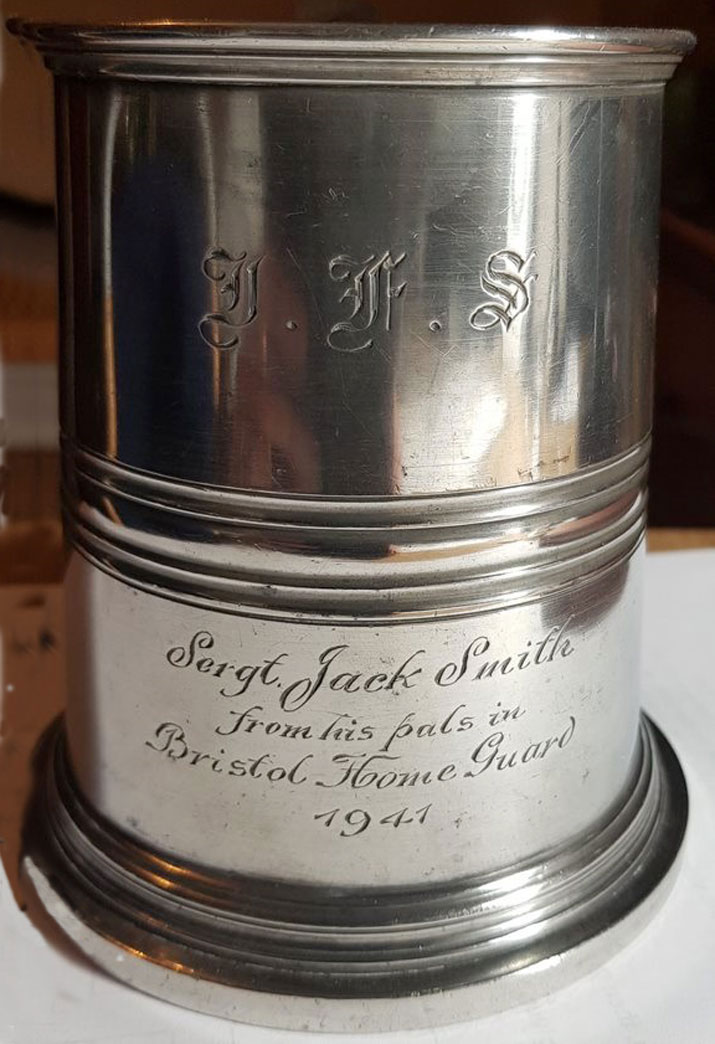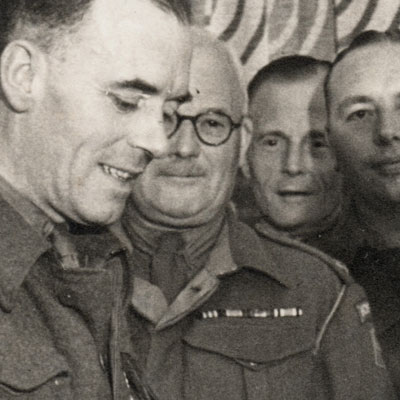Below,
Sergeant John Francis Smith
on parade with
“R”
Company, 11th
Gloster (City of Bristol) Battalion Home Guard
in
1941
(see References 5).
The 2nd Lieutenant is highly likely to be the same as in the
previous photo. The building directly behind the parade is the
then
St.
Alban’s Club, Cossins Road, Bristol,
their Headquarters. The window has since been blocked in.
Interestingly I note they are not wearing any “Home Guard”
shoulder titles, District, and Battalion numbers on their
tunics as in the previous photo.
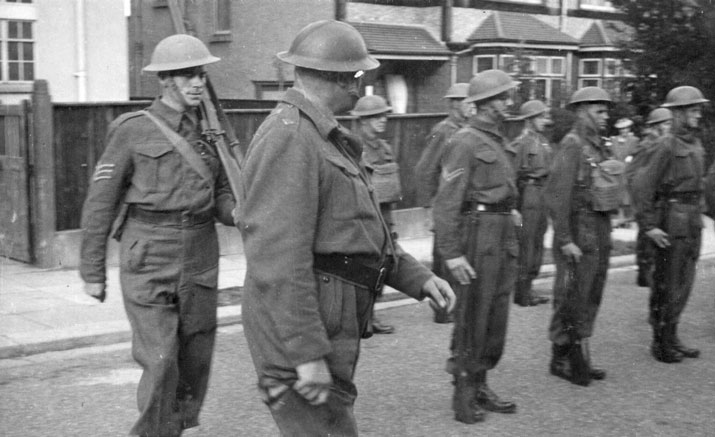
Click on image to view
magnified version
Volunteers of
“R” Company 11th Gloster (City of
Bristol) Battalion Home Guard
on parade at
Cossins
Road
(see References 5).
The Corporal is the same person presenting
the tankard to
John Francis Smith in
the previous photo.
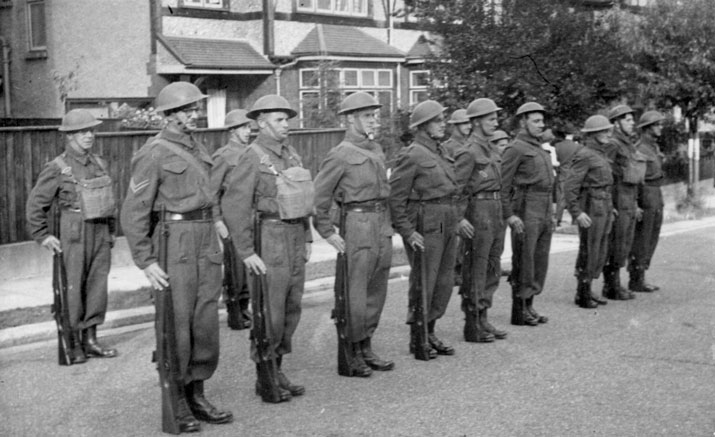
Click on image to view
magnified version
Below,
a
Home Guard Parade on
Durdham
Downs.
No date or specific details given on photo, but I would
suggest it is the 11th Battalion on parade on
Sunday September 28th
1941
,
as described by
Major Bromhead
when the City of Bristol Home Guard were inspected by
Field
Marshall Lord Birdwood.
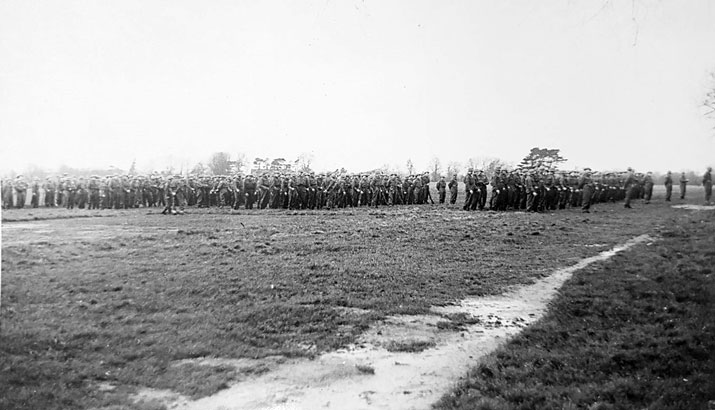
Click on image to view
magnified version
The
following photograph had no specific details, but perhaps shows
11th
Gloster (City of Bristol)
Battalion Home Guard marching proudly, behind, I believe,
Major J.H.
Bromhead,
from
Durdham
Downs
along
Redland
Hill
on
Sunday 28th September 1941,
following inspection by
Field
Marshall Lord Birdwood.
They are all very much marching in step, which is a testament
to the training they have done.
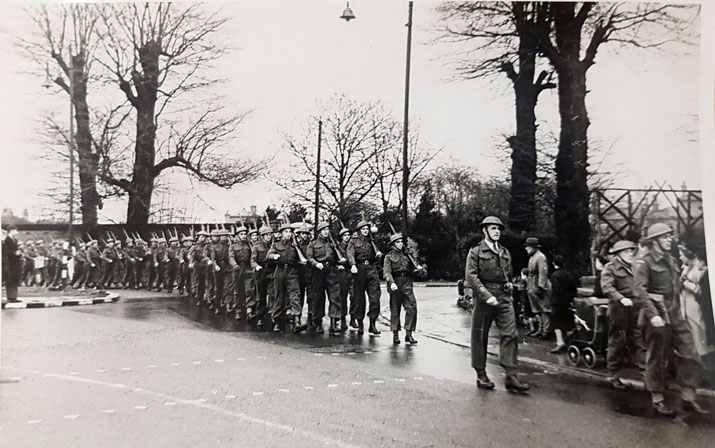
Click on image to view
magnified version
11th Gloster
(City of Bristol) Battalion Home Guard
marching from the parade at
Durdham
Downs
and
entering
Redland
Hill.
No specific details given on photo though I believe it is the
same parade as above. Could this be
“R” Company
being led by
Lt.
Jackson?
– by studying the comparison of physique, and especially the
hands,
with the 2nd Lieutenant
who is in the photo with
Sgt.
John Francis Smith
coming on parade in
Cossins
Rd,
there are similarities that lead me to believe it is possibly
the same person.
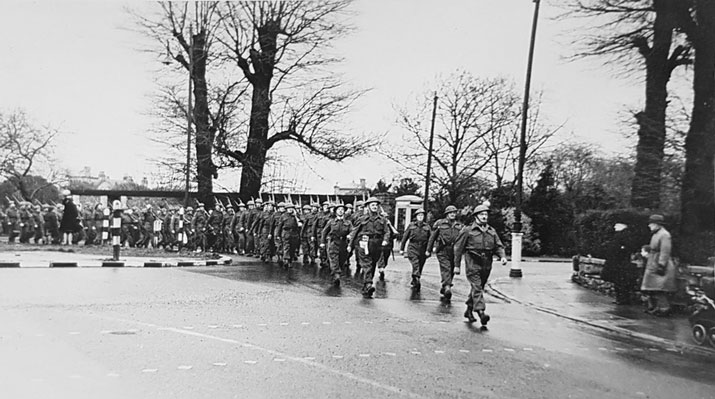
Click on image to view
magnified version
The previous three photos are subject to the copyright policy of
Bristol Archives.
Bristol Archives, 42421/Ph2: Photograph of Home Guard parade
on the
Downs
Bristol
Archives, 42421/Ph3-Ph4: Photograph of Home Guard march (?Redland)
The following photos are from the private collection
belonging to Richard Hope-Hawkins and my thanks go to
him for his permission to reproduce them here.
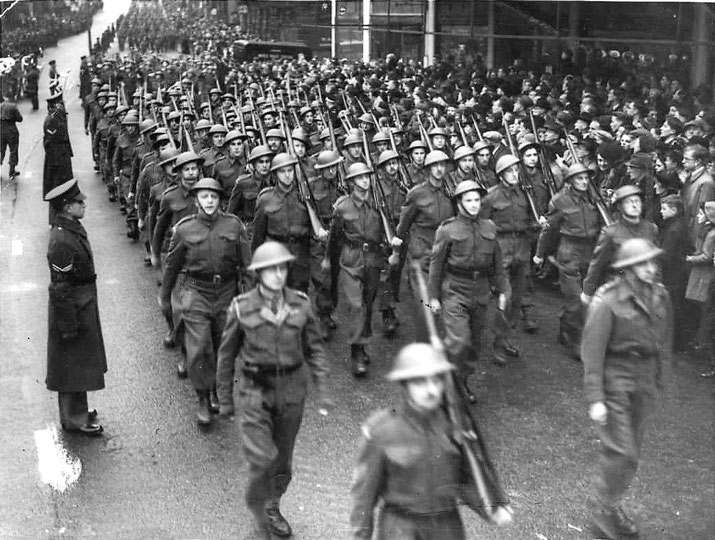
Click on image to view
magnified version
“S”
Company, 11th
Gloster (City of Bristol) Battalion Home Guard
marching past College
Green, Bristol on parade. Date
unknown, though there is a good possibility it is the “Warship
Week” parade of 3rd
December 1941 as mentioned in the
JHB History
(See JHB History
6.).
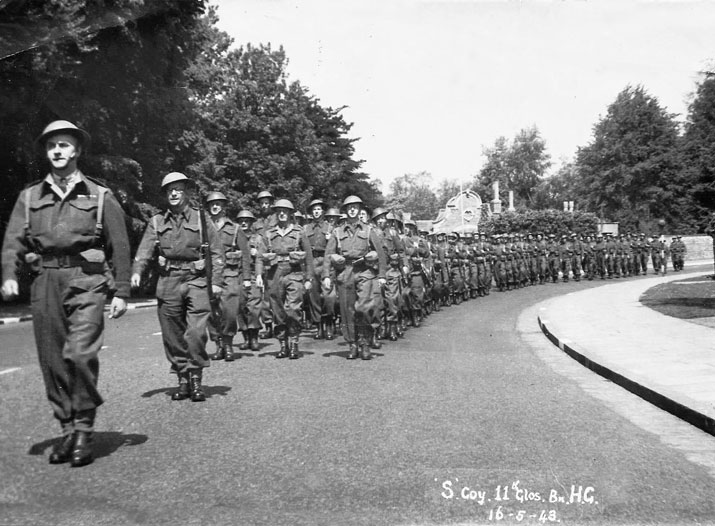
Click on image to view
magnified version
“S”
Company, 11th
Gloster (City of Bristol) Battalion Home Guard
on parade marching along
Westbury Road
towards
Durdham Down;
the entrance to Badminton
School can be seen in the
background.
A map showing
Cribbs Causeway
and surrounding areas circa 1941.
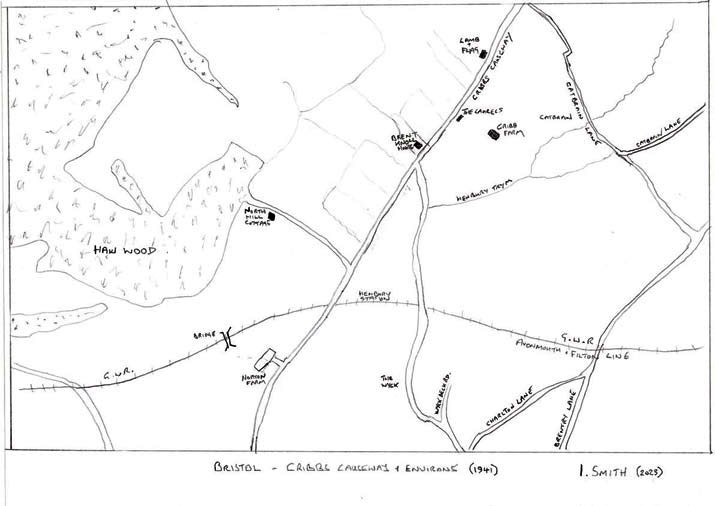
Click on image to view
magnified version
I have detailed
Haw Wood, North Hill Cottage,
Norton Farm, Brent Knoll House, Lamb & Flag and
Cribb Farm as places of interest that are mentioned
in the history memoir - Particularly the “Fighting patrol”
demonstration given by No.16 Platoon under
Lt. Jackson on
Sunday 5th
October 1941.
(See JHB History
5.).
**********
APPENDIX 1
I obtained a copy of John
Francis Smith’s enrolment form used upon joining the LDV in
1940
(see References 6)
. This is shown below. It also details some history of his
time with the Bristol and
Stafford Home Guard
units.
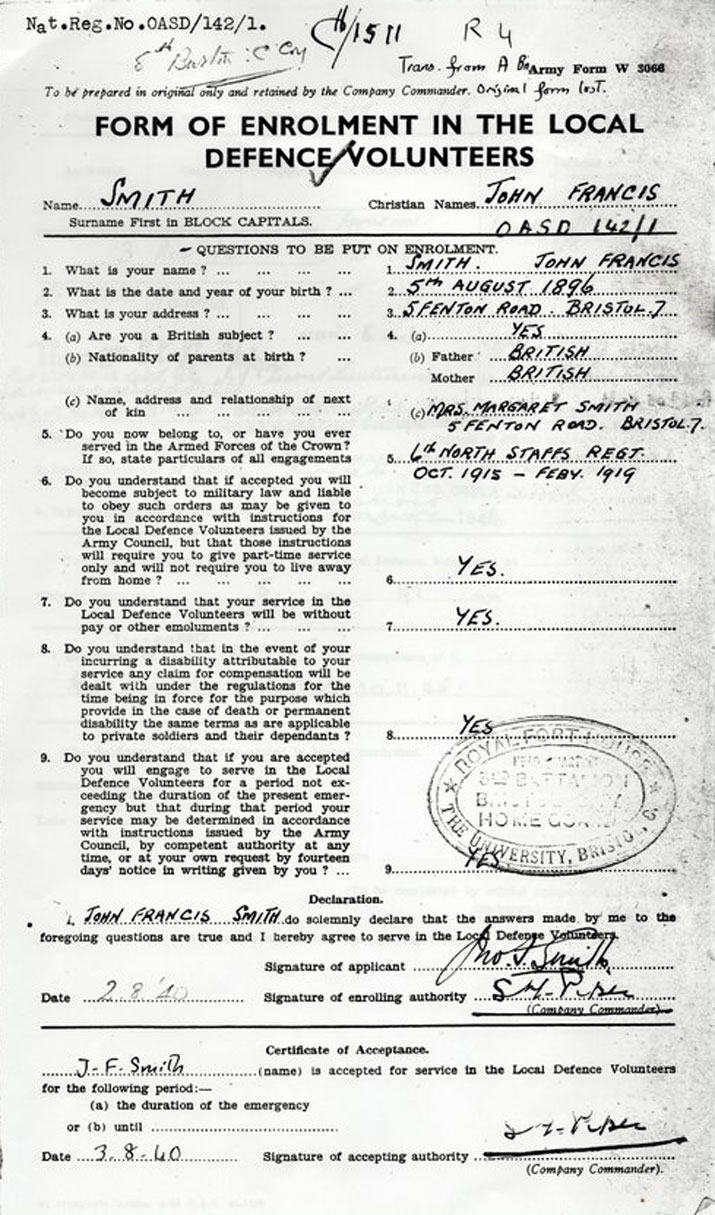
This is my interpretation of
what this form tells us.
We can see on the first page
of the form, above, which would have been filled in by John Francis’s
hand, he states the date when he joined the Armed Forces of
the Crown. This would have been the month in which he joined
the 2/6th
North Staffordshire Regiment.
This was exciting to discover –
I did not know this date from my other WW1 research as this
information was lost in the War Office archive fire in
September 1940.
The reference “OASD 142/1”,
just below his Christian name, was his National Identity
Number. A unique and key identifier for anyone looking to
apply for Home Guard service records.
(see References 7).
We can see he enrolled or
completed the form on 2nd
of August 1940, we have his signature to the right of this
date, and it is undersigned by the enrolling authority,
S. H. Piper, (Company Commander).
He was accepted for service on 3rd
August 1940.
There is some confusion about
the writing at the top of the form, which states, “Original
form lost”. What form would this have been? Possibly he
completed one enrolment form before this date, and it was lost
so he had to complete a new form? It also mentions “Trans.
from A Bn” (Battalion) - I am not sure about the reference to A Bn?
These two entries are written by the same hand.
At the top, we also have the
entry, “8th Battalion 'C' Coy." (Company), detailing which Company he was
assigned to after transferring to the
8th
North Staffordshire Battalion(Burton) Home Guard.
The large official stamp
reads:
"Royal Fort House, The University of Bristol, Headquarters 3rd
Battalion Bristol County Home Guard."
According to my
research, this Local Defence Volunteers (LDV) unit was
originally known as "C" Division.
It was later renamed "C"
Battalion, then the
3rd Battalion,
and finally the 11th Battalion
(Bristol) Home Guard in
January 1941.
Below is Page 2 of this document.
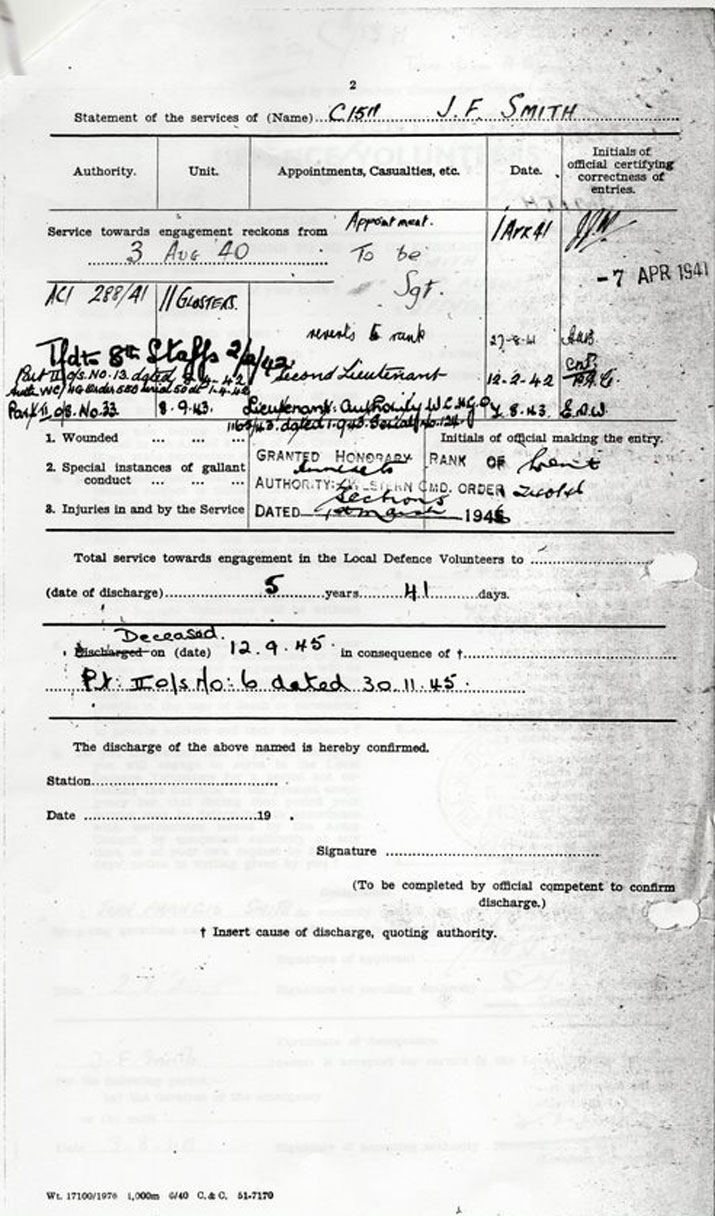
At the top of
page two, above, we
find, “C1511”, along with John Francis initials and surname. I
am assuming this could mean “C” Division and his number
assigned to him within what was to later become the
11th
Gloucestershire Battalion (Bristol) Home Guard. At the top on
page one, we can see a similar code though the “C” preceding
the number 1511 is somewhat fancier with two vertical lines.
Are these two vertical lines in reference to the 11th?
We can see in the table on
page two that there are several entries, deciphering and
understanding them is difficult as some are very vague and
appear incomplete – which is a shame.
The first entry,
“Appointment”, dated
1st
April 1941, initialled by
J.J. Whyte
(see References 8),
sadly, does not provide any information as to what he was
appointed to?
To the left is the “Service
towards engagement reckons from” date - 3 Aug 1940. This would
have been used to calculate the “Total service towards
engagement in the LDV”. This is stated on page 2. as 5 years
and 41 days. Whilst the Home Guard was Stood Down at the
beginning of December 1944, it officially continued in
existence until the end of December 1945, hence the date of
service is from enrolment until his death on
12th
September 1945. He may have continued serving with the HG in
some capacity during 1945.
Below “Appointment” we see
the entry “To be Sgt”, and to the left of this is the
Authority reference number “AC1 288/41” and the Unit “11
Glosters”.
In respect to the rubber
stamp of “7 Apr 1941” on the right. Is this rubber stamp with
reference to and confirming the “Appointment” entry above -
considering it was just six days later, or does it relate to
the reference number “AC1 288/41”? Both these entries appear
to be written by a similar hand.
My view is that I do not
believe the date of 7th
Apr 1941 has any reference to the “To be Sgt” entry, even
though it is adjacent. It appears that “To be Sgt” may have
been written at the same time as the “Service towards
engagement reckons from” date in 1940 - as they appear to be
of a similar hand and using the same pen.
If we examine the numbers “4”
in each of the written entries “3 Aug 40”; “1 Apr 41” and “AC1
288/41”, along with the “A” in “AC1” and “Appointment” they
appear to be of a similar hand - that is of J.J. Whyte, who we
know initialled the first entry, and who was involved in the
enrolment process. I also
believe J.J. Whyte
wrote the entry “C1511 J.F. Smith” at the top of page two.
From this, I conclude that
when John Francis enrolled on the
3rd
August 1940, he was earmarked
to be a Sergeant. The AC1 288/41 is I think in reference to
the “Appointment” entry, dated 1 Apr 41.
Following on we have the
cryptic entry “reverts to rank” dated
27th
August 1941, initialled by JHB (J.H. Bromhead). What rank he
reverted to and from is sadly not clarified on the form. We
know that the family moved to Staffs and this may have been
around this time as my father,
Peter Smith,
attended Burton Grammar
School from 1941 onwards, one
would assume he started Burton Grammar School at the start of
term in September 1941. One scenario could be he reverted from
the appointed rank - awarded on 1st
April 1941, back to Sergeant due to his impending transfer to
Staffs. However, this would mean the earlier appointment would
have been to the rank of 2nd
Lieutenant. Would this step up and down between commissioned
to non-commissioned ranks be too large a step? Another
scenario would take into consideration that he reverted to
Corporal from Sergeant, but why would this be the case if he
had earned the stripes and served as a Sergeant for some time
with the Company? A third scenario we can consider is that he
reverted to basic rank and file, i.e. a civilian, prior to his
transfer from Glosters to the North Staffs? Without access to
further evidence, it is all open to speculation. It is
interesting to note that J.H. Bromhead mentions in his history
of “R” Company, that around 16th
of April 1941 several appointments appeared in battalion
orders, and he lists several from 2nd
Lt through to Majors. John Francis Smith is not one of them that is listed,
but the term appointment is, I believe, significant here as it
is being used in respect of the award of commissioned ranks.
What we can positively
determine, is that John Francis officially transferred to the
8th
North Staffs on
2nd
February 1942, and only 10
days later is recorded as 2nd Lieutenant. It is unclear if the
initial of S.N. Piper
is in relation to the transfer to 8th North Staffs, however I
believe this to be most likely, the thickness of the pen line
being similar to the thickness of lines in the date “2/2/42”,
and that the transfer would need to be signed off by the
Commanding Officer of the Bristol Battalion.
What transpired
between 27th August 1941 and 2nd February 1942 is anyone’s guess, maybe John Francis had a
foot in both camps during this time?
We then have entries that
state:
-
Part II O/S. No.13. dated
8.4.42 Auth WC/HG Under 550 Serial 50 at 1.4.42
-
Part II O/S. No.33.
8.9.43, Lieutenant: Authority W.C.H.G.O. 1165/43. Dated
1.9.43. Serial No. 124. 7.8.43.
(O/S = Orders and W.C.H.G.O.
is Western Command Home Guard Order).
I consider the first Part II
orders, dated 8th
April and 1st
April 1942, to be the official confirmation of his appointment
to 2nd
Lieutenant on
12th
February 1942.
On
7th
August 1943 John Francis was
promoted to the rank of
Lieutenant, this was confirmed in
the Part II orders dated 8th
September 1943. The entries on the form were penned and
initialled by E.M.W.
Underneath these entries, we
can see that John Francis was granted the Honorary rank of
Lieutenant, (unreadable squiggle), Authority: Western Command
Order Sections 240146, dated 1st
March 1946. This was granted posthumously as he had passed
away in September 1945.
The final entry records his
date of death and the Pt II orders in reference to this dated
30th
November 1945.
